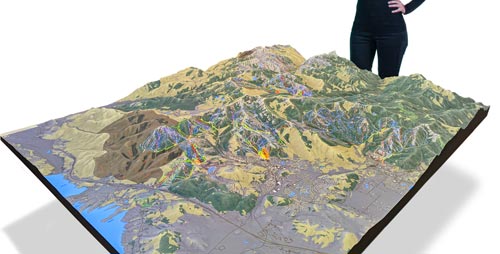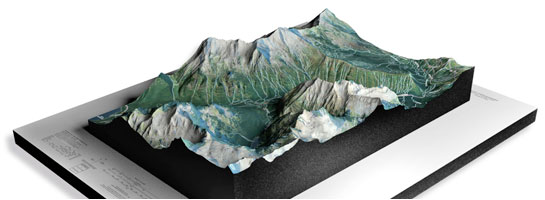Maps Glossary
WhiteClouds builds 3D Raised Relief Maps
Did you know we make
3D raised-relief maps

and
3D raised-relief maps

Natural Boundary
A natural boundary is a geographical feature that separates two regions or countries. It could be a river, mountain range, or a desert. These boundaries are formed by nature and are not created by humans. The natural boundary can also be an imaginary line that follows a physical feature. For example, the Rio Grande river forms a natural boundary between Mexico and the United States. These boundaries can sometimes cause conflicts, but they also provide a clear line of separation.
Natural Levee
A natural levee is a raised area of land that runs parallel to a river or a lake. It is formed by the deposition of sediment over time, which raises the level of the land. The natural levee acts as a barrier against flooding, and it helps to protect the surrounding areas from the water. Natural levees can be found along many rivers, including the Mississippi River in the United States.
Natural Resource
A natural resource is any material or substance that occurs naturally in the environment and is used by humans. Examples of natural resources include water, oil, coal, timber, and minerals. These resources are important for the economy and are used to create products that people use every day. Natural resources are finite, which means that they will eventually run out. It is important to use them wisely and to find alternative sources of energy and materials.
Nautical Chart
A nautical chart is a map that is used by mariners to navigate the sea. It shows the water depth, the location of hazards such as rocks and shoals, and the location of navigational aids such as lighthouses and buoys. Nautical charts are created using data from surveys and satellite imagery. They are an important tool for safe navigation and are required by law on all large commercial vessels. Nautical charts can be used in conjunction with a compass and other navigational equipment to plot a course and navigate to a destination.
Nautical Map
A nautical map is a type of map that is specifically designed for use in navigation on the sea or other bodies of water. These maps show the coastal features, water depths, and other important information that is necessary for safe navigation of ships and boats. They may also include information about tides, currents, and other marine conditions. Nautical maps are essential for commercial shipping and fishing, as well as for recreational boating and sailing. They are often used in combination with navigational instruments like compasses and GPS devices to help ensure accurate and safe navigation.
Nautical Mile
The nautical mile is a unit of measurement used in navigation, and it is equal to one minute of arc along the Earth’s meridian. It is used to measure distances on the sea or in the air. One nautical mile is equal to 1.852 kilometers or 1.1508 miles. It is important to use nautical miles when navigating because the Earth is not a perfect sphere, and distances can vary depending on the latitude.
Navigation
Navigation is the process of determining a course or direction and following it to reach a destination. It is an important skill for mariners, pilots, hikers, and anyone else who needs to travel from one place to another. Navigation can be done using a variety of tools, including maps, compasses, GPS devices, and nautical charts. It is important to be aware of potential hazards such as rocks, shoals, and weather conditions while navigating.
Neck
A neck is a narrow strip of land that connects two larger land masses. It is often formed by erosion or the movement of water over time. The neck can be a strategic location for transportation or defense, and many cities and fortifications have been built on necks throughout history. One famous example is the Corinth Canal, which was built to connect the Gulf of Corinth to the Aegean Sea and cut through the Isthmus of Corinth.
Negative Relief
Negative relief is the opposite of positive relief and refers to areas on a map or landscape that are lower than the surrounding area. These can be valleys, canyons, or depressions. Negative relief is important in understanding the topography of an area and can be used to identify potential flood zones or areas prone to landslides.
Nepheloid Layer
The nepheloid layer is a layer of turbid water in the ocean that is made up of suspended particles such as plankton, silt, and other organic matter. It is important because it plays a role in the ocean’s carbon cycle, and it can affect the distribution of nutrients and other substances in the water. The nepheloid layer can be studied using specialized equipment such as sensors and imaging technology.
Neutral Density Filter
A neutral density filter is a camera accessory used in photography to reduce the amount of light entering the camera lens without affecting color balance. It is a gray-tinted filter that can be adjusted to different levels of light reduction, allowing photographers to use slower shutter speeds or wider apertures in bright light conditions. Neutral density filters are commonly used in landscape photography to capture long exposures of waterfalls or other moving water features.
Niche
A niche refers to a specific role or position that an organism occupies in its environment. It is the way in which an organism interacts with other organisms and its physical surroundings. A niche can be defined by factors such as food sources, temperature, moisture, and other environmental factors. Organisms that occupy a niche must be adapted to the conditions of that niche, and competition for resources can drive evolution and species diversification.
Nonconformity
A nonconformity is a geological term that refers to a boundary between two rock formations where the older rock has been eroded away, and the younger rock rests directly on top of it. This can happen over long periods of time due to erosion or tectonic activity. Nonconformities can provide important information about the geological history of an area and can be used to reconstruct past events such as volcanic activity or glaciation.
Non-point Source Pollution
Non-point source pollution is a type of pollution that originates from many diffuse sources, rather than from a single, identifiable source. It is often caused by runoff from agricultural or urban areas, which can carry pollutants such as sediment, fertilizer, and chemicals into nearby waterways. Non-point source pollution can be difficult to control because it comes from many sources and can be difficult to measure. Best management practices such as erosion control and stormwater management can help reduce non-point source pollution.
NOAA Map
A NOAA map is a type of map produced by the National Oceanic and Atmospheric Administration (NOAA), a federal agency responsible for monitoring and forecasting weather, climate, and ocean conditions. These maps are used to provide information on a wide range of topics, including weather patterns, ocean currents, and marine life. They may also include information about natural hazards like hurricanes, tornadoes, and tsunamis, as well as man-made hazards like oil spills and other environmental disasters. NOAA maps are used by a wide range of people and organizations, including scientists, emergency responders, and the general public. They are also used in education and outreach activities to help people better understand the complex relationships between the environment and human activities.
Normal Fault
A normal fault is a type of geological fault where the hanging wall moves downward relative to the footwall. This can happen when tension forces cause the Earth’s crust to stretch and pull apart. Normal faults are common in areas with high volcanic activity and can cause earthquakes when the movement of the plates along the fault line is sudden and rapid. The hanging wall and footwall can be used to identify the orientation of the fault line relative to the Earth’s surface.
North Arrow
A north arrow is a symbol used on maps and other graphical representations of geographic data to indicate the direction of north. It is usually represented as a straight arrow pointing upwards and labeled “N” or “north.” North arrows are important because they provide a reference for orienting the map or diagram and help users understand the direction of geographic features and the layout of the area being represented.
North Seeking Arrow
A north-seeking arrow is a device used to align a compass to true north. It is a small magnet or magnetic needle that aligns itself with the Earth’s magnetic field and points towards magnetic north. North-seeking arrows are often used in surveying and navigation to ensure that compass readings are accurate and aligned with true north.
Northern Hemisphere
The northern hemisphere is one of the two halves of the Earth, divided by the equator. It includes all of the land and water located north of the equator, and it contains the majority of the Earth’s landmass and population. The northern hemisphere is home to a wide variety of climates and ecosystems, from the frozen tundra of the Arctic to the tropical rainforests of Southeast Asia. Understanding the geography and topography of the northern hemisphere is important for understanding global climate patterns and environmental trends.
Null School
A null school is an online tool that allows users to visualize current wind patterns and ocean currents across the globe. It provides a real-time view of atmospheric and oceanic conditions and allows users to see how these conditions are changing over time. The null school uses data from a variety of sources, including weather satellites, buoys, and other sensors, to create interactive maps and animations that can be used to study weather patterns and predict future weather events.
Nunatak
A nunatak is a rock formation that protrudes through a glacier or ice sheet. It is a type of landform that is typically found in polar regions or high altitude areas where glaciers are present. Nunataks can range in size from small outcroppings to large mountains and can provide important clues about the geologic history of an area. They are often used as landmarks by explorers and researchers and can serve as important sites for scientific study of glacial dynamics and climate change. Understanding the features and characteristics of a nunatak is important for understanding the role of glaciers in shaping the landscape and the impact of climate change on polar regions. Nunataks can also be used as reference points for navigation in remote and rugged terrain, making them important features for hikers, climbers, and other outdoor enthusiasts.